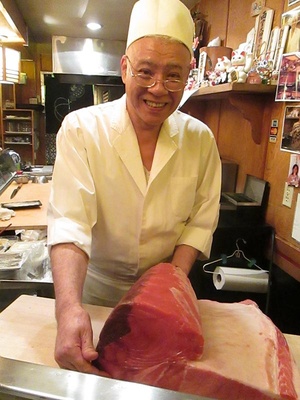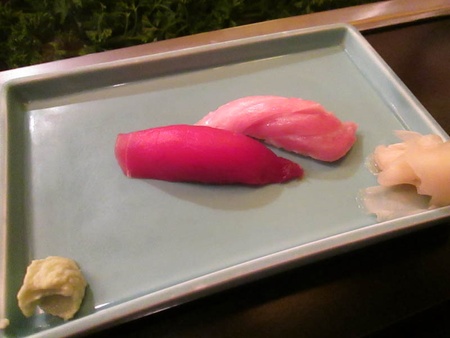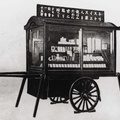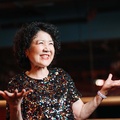99% of the customers at this long-established restaurant are American
The restaurant is located between downtown Los Angeles and Koreatown. I don't know what the environment was like in the 1970s when the restaurant opened, but now it is concentrated in Hispanic stores, as can be seen from the surrounding signs. The sushi restaurant stands alone in a place where there are no other Japanese restaurants.

Shige-san prepares the tuna. Even using the most delicious parts requires the experience of a craftsman.
The name of the restaurant is Shibucho. As one of the oldest restaurants in the country, there is probably no one in Los Angeles who doesn't know about it. However, whether you've ever been there is another story. I had never been there until I visited in the fall of 2013 to hear a talk by the owner, Shigeru Kudo (hereafter Shige-san).
Although it seemed intimidating, once you step inside, you'll find it to be a relaxing and comfortable space. On the wall behind the kitchen, there are many photos of Shige-san and celebrities. You can also see Ron Wood of the Rolling Stones and actor Jack Black. The friendly atmosphere tells you that they are regulars at the restaurant.
It has been featured in the LA Times and Food & Wine magazines as a "must-visit sushi restaurant." However, I have rarely seen it featured in Japanese media. I wonder if it's because of the location or what.
"99% of our customers are white," Shige says. "I think that since we're in America, it's pointless if we don't cater to Americans, not just Japanese people."
The combination of wine and sushi has captured the hearts of American customers. Moreover, the sushi is authentic Edomae nigiri, completely free of mayonnaise or spicy sauces. "I don't make anything spicy that I don't think tastes good," he says. However, when it comes to appetizers, he has made a complete turnaround, serving dishes inspired by his visits to Italian and French restaurants. "I'm not saying tempura is bad, but I want to do something different if possible," he says, and this feeling is expressed in his Western appetizers.
"The sushi itself is the same as in Japan. But we ask American customers about any foods they don't like and don't serve them. After all, we want them to come back to the restaurant. If they never come back, there's no point. Even if it's called omakase sushi, the chef shouldn't force his or her own preferences on the customer. I think omakase sushi shouldn't become a hard sell."
A sense of responsibility to carry on Japan's food culture
Shige-san came to America in 1971. "My purpose in going to America? There was no such thing. I was transferred to this restaurant from a sushi restaurant called Horikawa in Tokyo. In those days, you couldn't even get a visa. I have a 48-year career in sushi. Huh? A long time? That means you've never met a real sushi chef, right? I think that's the normal length of experience for a sushi chef."
He jokes that after 48 years of making sushi, he doesn't feel like eating sushi himself. On his days off, he frequents the restaurant of an Italian restaurant owner who is a regular at Shibucho. He also has an extensive wine collection.
"Our customers have always been Italian. They go to places like REX and MADEO in downtown. We frequent each other all the time. If I'm going out to eat by myself, there's no point in me not going to the real thing. It's also for learning purposes."
Shige, who is originally from Hokkaido, began training at a sushi restaurant in Tokyo after graduating from junior high school. "I was able to learn the skills of a craftsman while getting paid, so there's nothing more wonderful than that."
Yes, he is proud to be a sushi chef who is responsible for the culture of sushi in America. "There are people who understand the world of sushi chefs and people who don't. As a chef, I have to take pride in knowing the dishes I should serve. And I have to take responsibility for what I serve."
Shibucho was opened in 1975 by Shibuya-san, a senior craftsman. Shige-san took over the business and has been the owner since 1985.
"If you serve delicious food, the customers will know. As a craftsman, you sell your skills, but you don't curry favor. It's a sense of responsibility to serve customers Japan's proud food culture. That's what I think, but I hardly sense that kind of spirit among today's Japanese people living in a foreign country like America. Even when it comes to sushi, there are a lot of people who just cut it and serve it without knowing how to make it taste good, right?"
The awesomeness conveyed through one piece of sushi
Shige emphasizes that experience is necessary. With experience comes a sense of responsibility. And with that responsibility comes the ability to make sushi based on experience.
"Fish is naturally prone to spoilage, so you need the skills to know how to wash it and how to scrape off the skin when using it. You then need to use the best parts. Inexperienced people will waste a lot. Then there's the sushi rice. This is the most important thing. According to the teachings of the ancients, sushi rice is a layer of skin, but it's different for American rice and Japanese rice. California rice doesn't absorb water well, so in fact it doesn't even need to be rinsed. Rinse it once, and then rinse it many times after that. In my experience, you should also soak it in water for 30 minutes before cooking. Of course, the time will differ between summer and winter. We then add dashi kelp and cook. This is our sushi rice."
His experience level changes every day. Taking into account the weather and the condition of the ingredients, he comes up with the best way to cook the rice to its most delicious state. Shige says that's what a craftsman should be like.
"There is no manual. It's not easy to imitate. And the taste changes depending on the chef. So customers find a chef they like and go there regularly."
However, "modern Japanese people" tend to neglect sushi training. Shige-san purchases the ingredients, prepares the ingredients, and makes the sushi all by himself.
"The ability to listen to others without complaining is necessary for training. This isn't a school. But I will teach those who are willing to learn. But there aren't many people like that (those who are willing to learn), are there? People these days are internet people. They think that even if you don't have experience, you can just search and find out how to make sushi."
It may sound harsh when written down, but Shige's "attitude of sincerity towards sushi" is easily understood thanks to his humorous way of speaking. And the "experience" and "sense of responsibility" that he repeatedly repeats are persuasive just by putting a piece of nigiri in your mouth. You want to eat it again. That is the power of his sushi. "You can tell it's real when you eat it," Shige's words still ring in my ears.
Sushi Shibucho
3114 West Beverly Blvd., Los Angeles, CA 90057
Monday- Saturday 6:00pm-12:00am
Closed Sunday & Holiday
TEL: (213)387-8498
© 2013 Keiko Fukuda











